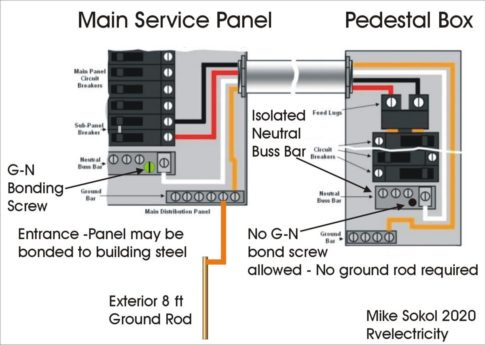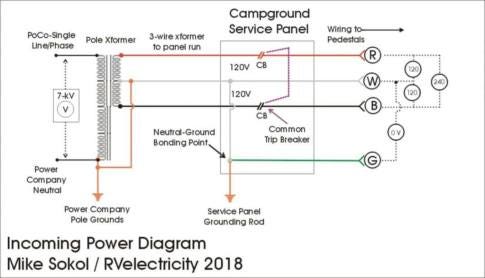How is my RV grounded?
And no, a ground rod does not actually “ground” your RV!
Dear Mike,
People are always talking about how a bad ground on an RV can cause problems such as a hot-skin condition. So how exactly is an RV grounded? I don’t see a ground rod anywhere. I’m pretty stupid when it comes to electricity, so can you please explain? —Sam (the Sham)
Dear Sammy,
You don’t mind if I call you Sammy, do you????
[From the editor: You can call him Sammy if he can call you Mikey.]
This is a great question that confuses a lot of electricians and even electrical engineers at times, so don’t feel stupid. I’ll show you how your RV is supposed to get its ground connection if it’s properly wired. But since this is a basics article I’ll save the in-depth explanation for another time.
Just the basics
The ground wire of your RV’s shore power cordset is connected (bonded) to your RV’s chassis on the one side, and the power company’s service panel Neutral / Ground bonding point on the other side.
Yup, your RV doesn’t have to have any sort of ground rod to be “grounded” since the green conductor in your power cord (technically called the EGC for Equipment Grounding Conductor) provides that grounding (fault current) path.
Isn’t earth a good enough ground?
No…. In fact, a ground rod is a pretty poor ground since the dirt beneath our feet isn’t a great conductor of electricity. It can be anywhere between 25 to 100 ohms. Certainly that’s conductive enough to get shocked, but it’s not enough of a conductor to trip (clear) a circuit breaker in the event of a line-to-chassis short circuit.
How do I know this?
Well, first of all it’s written right into the electrical code and all my engineering textbooks. But I recently did an experiment where I confirmed just how much fault current an 8-foot ground rod could get rid of, and it’s not much more than a few amperes. So if a ground rod doesn’t actually ground your RV, what does?
Your RV’s electrical ground is dependent on the aforementioned green ground conductor in your shore power cord being properly connected to the service panel’s neutral/ground bonding point either at your house or the main electrical service panel of the campground your RV is plugged into.
Where does the ground wire connect?
Note that the campsite power pedestal doesn’t require a ground rod, nor should it have a ground/neutral bond (that green screw). That neutral bond is only allowed to occur at one place, which is inside of the main service panel. Note in the diagram that this connection is also where the bare copper wire from the power company service panel’s ground rod is connected to. So it’s actually a Ground/Neutral/Earth bonding point where they all come together. And that’s what your RV chassis is eventually connected to.
Keeping grounded…
This is a great reason to maintain your shore power cords properly, including any dogbone adapters or extension cords. Never use a damaged electrical cord or connector since it can cause all kinds of problems.
OK, everyone. Remember that electricity is a useful and powerful force, so we all need to pay attention to safety precautions while using it.
Let’s play safe out there… Mike








Great intro, thank you! I echo Steve's question about grounding when not connected to shore power. I'm looking to build a little battery system for a small travel trailer and don't want to fry myself. I'm looking at a small ~700W solar array and two 12V LFP batteries in parallel into a 24V AIO hybrid solar inverter.
Hello Mike,
Very informative series you have. Most of what you explain makes sense to me, what I don’t understand is how an RV can be grounded if it’s not connected to shore power. The reason I am asking is my sister-in-law has a camper that’s experiencing problems with the remotes used for the truma caravan movers. From the info you provided it appears there might be a problem with the grounding. But all of the problems she is experiencing with the 12v system are before she connects to shore power.